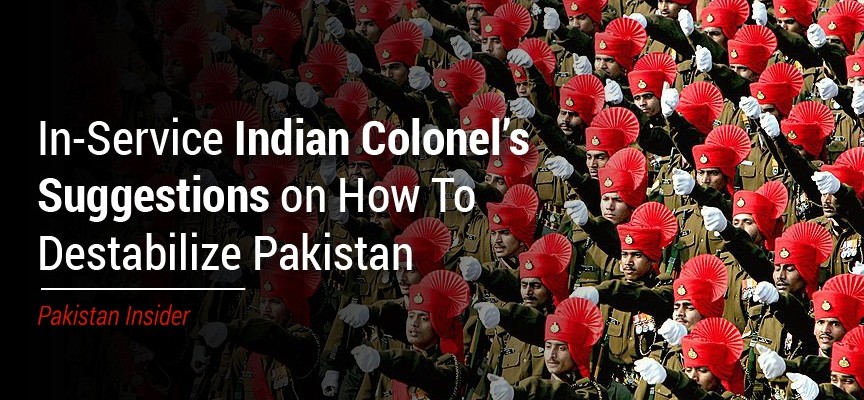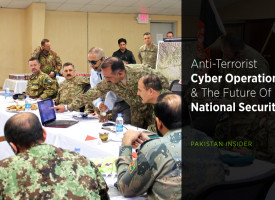Colonel Kirit K. Nair is an in-service (serving) officer in the Indian Army. He was commissioned to 1 Sikh Light Infantry in March 1992. He has served extensively in Counter Insurgency (COIN) operations in occupied Jammu & Kashmir and Assam. He is currently on Study Leave for a post graduate degree program.
In early 2015, Nair published a paper for Indian Army’s Centre for Land Warfare Studies (CLAWS) titled ‘India’s Role in Afghanistan Post 2014: Strategy, Policy and Implementation‘. He has presented Indian military establishment’s collective ambitions and hegemonic objectives in Asia, particularly Central Asia and the Indian Ocean, in great detail.
Like his contemporaries and peers in the Indian Army, Nair too believes that Pakistan’s military is engaged in some sort of “strategic depth” in Afghanistan and allegedly support Islamist forces there, particularly the Taliban. Nair’s frequent assertions that Pakistan wants to make its foothold in Afghanistan more rigid to counter India’s ‘peaceful’ ingress into Central Asia reflects a paranoia-infected attitude which has damaged the collective Indian conscious to a large extent. In fact, it is this very mentality which has given birth to a barrage of statements by New Delhi’s military, diplomatic, political and economic intelligentsia which vehemently accuses Pakistan of being an alleged state sponsor of terrorism (without concrete evidence, as always).
Without going into the irrelevant details of his otherwise academic paper, I will examine some of Nair’s proposals on how to destabilize Pakistan for allegedly retarding India’s overtures on Afghan soil and Central Asian Republics (CARs).
The remarkable aspect to all this is that unlike other members of the Indian military intelligentsia who are obsessed with Pakistan and write on a variety of issues related to it, Nair is a serving officer; being in the Colonel rank (mid-level position) reflects the type of mindset prevailing in the Indian Army’s coming generation of officers.
Exploiting the ‘Pashtunistan’ issue
Nair examines the fault lines in FATA, especially the fact that the tribal regions are out of Pakistan’s official state jurisdiction. He says that although development in KP is somewhat existent, it is not considerable enough. The only meaningful infrastructure there, according to Nair, is for defence logistics.
According to Nair, the Durand Line (line dividing Afghanistan and Pakistan) has never been recognized by any Afghan regime, including Pakistan’s own alleged asset, the Taliban. He says that the vast majority of terrorist groups purportedly based in KP and FATA comprise of Pashtuns; when they allegedly execute attacks in Afghanistan, Pakistan shirks responsibility citing no control over the tribal regions which, according to Nair, is a mark of cunning gameplay. To counter Pakistan on this issue, Nair has suggested the following measures:
1. Antagonize the Pashtun majority against Pakistan if the latter rejects such a proposal. For Pakistan, this would be a ‘lose-lose’ situation because if it agrees, the Durand Line will get world attention which will certainly be undesirable for Pakistan; if it doesn’t agree, then a particular lot of (pro-Afghan) sensitive Pashtuns will raise hue and cry over the issue and accuse Pakistan of violating their communal/ethnic rights.
2. India can give recognition and support for an independent ‘Pashtunistan’ to exert pressure on Pakistan (as it is already doing covertly in the case of Balochistan and Sindh). Nair is mindful of a situation in which elements of the Northern Alliance (ethnic Tajiks by majority) might have reservations over India’s outright support for rival Pashtuns. In such a case, Nair says, India can bring the Pashtunistan issue to the notice of “certain other countries” which, according to him, “share the similar concerns about Pakistan”. I will rather not speculate on which countries he could be referring to.
3. By internationalizing the Durand Line issue, India can expose Pakistan’s “bluff” about its alleged strategic depth policy vis-a-vis India. In this way, India can try to convince the global community about alleged foul playing by Pakistan.
4. According to Nair, internationalizing the Durand Line issue will generate internal turmoil with the federation versus Pashtun community and, as a result, Pakistan can be kept busy dealing with instability in KP and FATA.
5. Nair believes supporting Pashtunistan will be “an added bonus” for India as Pakistan will focus completely on handling a further-degenerated internal security situation and, meanwhile, India will be able to make ‘trouble-free’ ingress into CARs via Afghanistan and Iran.
Balochistan
Nair claims Balochistan was “forcibly annexed” by Pakistan Army in 1948 (a faulty claim, as proved here). While touching on the grievances among neglected Baloch and Hazara Shia communities, he recommends that India should support the cause of Baloch separatism through diplomacy and internationalize the issue just like the Pashtunistan cause.
Moving on, Nair says that if India’s diplomatic channels are unable to attract international attention on Pakistan’s alleged proxy wars in its neighboring states, then, in his words, India should “aggressively assist in creating the logistics support, infrastructure and financing for the Baluch cause for independence”. It is clear from his assertion that by ‘India’ here, he is referring discreetly to its military establishment.
Balawaristan – The Northern Areas
Balawaristan is the historic name for Gilgit-Baltistan region which includes the cities of Gilgit, Skardu, Hunza, Ishkoman, Puniyal and Yasin. Echoing the widely-held Indian beliefs, Nair claims Pakistan has been “in occupation” of Balawaristan.
Sharing his awareness of the fault lines prevalent in Gilgit-Baltistan at present, such as political discontent and targeting of minority Shias, Nair says there is growing demands among sections of the Balti community to separate from Pakistan. He cites formation of the Balawaristan National Front as one of such expressions.
Nair suggests India should support the ‘independence of Balawaristan’; this issue too, he asserts, should be internationalized by the Indian establishment. He believes that quoting killing of Shias at the hands of Sunni terrorist groups like Sipah-e-Sahaba Pakistan (SSP) and Lashkar-e-Jhangvi (LeJ) can add weight to India’s arguments before the global arena.
Conclusion
The above-mentioned excerpts and my personal commentaries attached to them are indicative of a new generation of Indian Army officers who are more ‘geostrategic’ in thinking and for whom Pakistan is the ‘source of all evil’. While it is true that on-ground realities offer different perspectives than drawing-room scenario-building, the fact cannot be ignored that the next crop of India’s military high command is Pakistan-centric.
That India perhaps has ‘far better things to look into than Pakistan’, as claimed by a certain lot of Indian analysts, is a superfluous claim, laid bare in the article above.
image credit: wikipedia.








Indian is destine to succumb into its own weight… in a country where the huge majority of the population is below the poorest level of poverty in the entire world… if Indian doesn’t do anything to remedy this problem… it could collapse by its own inequalities.